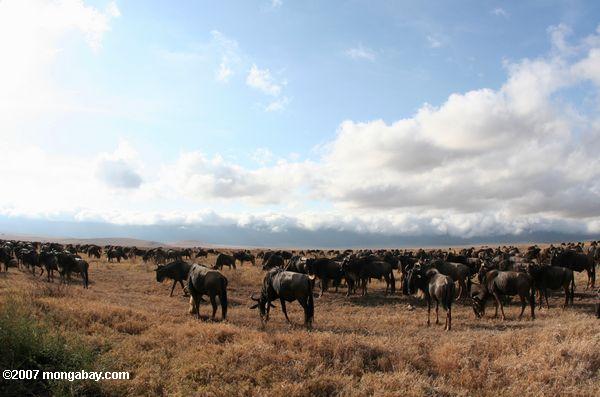The World Bank has offered to help fund an alternative route for a planned road project that would otherwise cut through Tanzania’s world famous Serengeti National Park, according to the German-based NGO Nature and Biodiversity Conservation Union (NABU). When announced last year, the road project raised protests from environmentalists, scientists, and Tanzanian tour companies, but the Tanzanian government refused to shift plans to an alternative southern route for the road, thereby bypassing the park.
According to NABU, however, the World Bank may be preparing to settle the dispute. Reportedly the bank is opposed to the route that would cut through the Serengeti, and provide funding for the alternative plan.
“The regular pulse of the migration is the very heartbeat that keeps the Serengeti alive,” says Dr Barbara Maas, NABU International’s Head of International Species Conservation. “Without it, it will die. The World Bank’s initiative throws a lifeline to this unique wilderness and the animals and people that depend on it.”
The Serengeti is home to one of the world’s last intact migrations of large terrestrial mammals, as every year one and a half million wildebeest along with hundreds of thousands of zebras and Thomson’s gazelles brave lions, crocodile-infested rivers, and humans to migrate to seasonal grazing.
Renowned East African conservationist, Richard Leakey, stated that while road may start out as a dirt track rising human populations would eventually force its expansion, which would “kill the migration”.
Even without new roads, mammal populations in Africa are declining. A study last year found that large mammals in protected areas saw an overall decline in their populations of 59% in the past 40 years.

Wildebeest herd in Tanzania. Photo by: Rhett A. Butler.
Related articles
Africa’s vanishing wild: mammal populations cut in half

(01/27/2011) The big mammals for which Africa is so famous are vanishing in staggering numbers. According to a study published last year: Africa’s large mammal populations have dropped by 59% in just 40 years. But what is even more alarming was that the study only looked at mammal populations residing in parks and wildlife areas, i.e. lands that are, at least on paper, under governmental protection. Surveying 78 protected areas for 69 species, the study included global favorites such as the African elephant, giraffes, zebra, wildebeest, and even Africa’s feline king, the lion. “We weren’t surprised that populations had dropped but we were surprised by how large the drops had been,” lead author Ian Craigie told mongabay.com in an interview.
Threatened on all sides: how to save the Serengeti

(09/27/2010) Tanzania’s plan to build a road through the Serengeti has raised the hackles of environmentalists, conservationists, tourists, and wildlife-lovers worldwide, yet the proposed road is only the most recent in a wide variety of threats to the Serengeti ecosystem. A new study in mongabay.com’s open-access journal Tropical Conservation Science looks at the wide variety of issues facing the Serengeti and how to save one of the world’s most beloved landscapes and wildlife communities.
Road through the Serengeti will eventually ‘kill the migration’

(07/08/2010) Tourists, conservationists, individuals, and tour companies have launched an international outcry against the Tanzanian authorities in response to the announcement of the planned construction of the trans-Serengeti Highway highway. There is even a Facebook group and an online petition with 5,038 signatures. But the government has responded by saying that the plans are still on course.